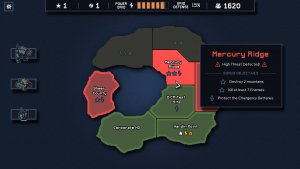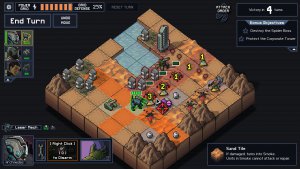Into the Breach is pure, tactical, turn-based strategy at its finest.
I could start by telling you how I heard about Subset Games and FTL. That I have played hundreds of hours of FTL across multiple platforms. That I am a huge fan of the strategy genre, having played games like Shining Force, Fire Emblem, Advanced Wars and more since I was a kid.
Forget all that — the reason why is simple. We need to talk about Into the Breach and I don’t wanna waste any time. Let’s just get straight into it.
Into the Breach may be one of the best strategy games of the year. Its simplicity almost lends itself to a board game (and I wouldn’t be surprised to see that soon). When I first started Into the Breach, my immediate thoughts were that this was like chess, but nightmare chess. Not that it’s overly complicated or dull — each move just needed to be planned carefully and precisely. I would stare at the screen for up to five minutes, plotting many moves ahead, petting my dog like a Bond villain as I planned the Vek’s demise.
There is quite a bit to unload when it comes to Into the Breach. There are multiple layers and complexity to each element. So if I don’t cover something, don’t shoot me. Also, you may see me compare this to FTL many times. While they are very different types of games, they do share many similar ideas in design.
Layers, so many layers.
Subset games brought quite of bit of FTL into its next title. The concept, controls and progression all feel the exact same. Beginning with the gameplay/concept — if you look at FTL, it wasn’t really about anything more than getting from left to right and defeating the boss. Into the Breach follows suit with a similarly easy concept: survive. The enemy is called the Vek and they have already won. You are a time-travelling pilot who goes back to try to change things Terminator-style. You have three mechs and an onslaught of Pacific-Rim–style monsters to defeat.
 The goal? Your mechs need to protect the grid and survive. The grid is essentially your life bar, represented by buildings which are spotted around an isometric grid map. These represent the civilian population and other important resources. The Vek are dumb in nature and usually charge at whatever is closest to destroy it — if the grid falls, it’s game over. The difficulty of the game is in having a limited number of units compared to the overpowering Vek.
The goal? Your mechs need to protect the grid and survive. The grid is essentially your life bar, represented by buildings which are spotted around an isometric grid map. These represent the civilian population and other important resources. The Vek are dumb in nature and usually charge at whatever is closest to destroy it — if the grid falls, it’s game over. The difficulty of the game is in having a limited number of units compared to the overpowering Vek.
All hope is not lost, though. Your mechs are highly advanced machines which come with an assortment of powers and upgrades to counter the Vek movements. All of this plays harmoniously into a wonderful, bite-sized game. Into the Breach displays the enemies’ moves and it’s your job to move, kill or nullify the enemy and its attacks. Throw in different mech loadouts and you have enough possibilities and strategies to boggle the mind. Each class of mech has a variety of attack types from ranged, science, brute and the powerful prime mechs.
If that wasn’t enough, you also have different pilots, each with their own unique traits, able to level up and gain more benefits. Now, Into the Breach features RPG elements and rogue-like elements but it isn’t exactly the focus of the game. If you are expecting a rich RPG like Final Fantasy Tactics or other isometric strategy games, you’re barking up the wrong tree. This is a simple, refined strategy game that is hard as nails even on the easy difficulty. It takes bits and pieces of genres and refines it down to something simple to digest, but ridiculously hard to master.
 The rogue-like elements are there, but you know what to expect every level — sometimes there are bonus objectives on the map to keep things from ever getting stale. The core of the game is the same, though: survive and protect the grid. I would go as far as saying this does sometimes feel like a puzzle game, but that isn’t a bad thing. I have seen some complaints about the size of maps and I think people are missing the point. Making a chess board bigger doesn’t really change the game. The level design is spot on in my opinion, as neither the Vek nor you waste a turn — there is always imminent danger and every move counts.
The rogue-like elements are there, but you know what to expect every level — sometimes there are bonus objectives on the map to keep things from ever getting stale. The core of the game is the same, though: survive and protect the grid. I would go as far as saying this does sometimes feel like a puzzle game, but that isn’t a bad thing. I have seen some complaints about the size of maps and I think people are missing the point. Making a chess board bigger doesn’t really change the game. The level design is spot on in my opinion, as neither the Vek nor you waste a turn — there is always imminent danger and every move counts.
Could the game have more RPG elements or even deeper strategy elements? Sure, but I think it would ultimately distract from the purity the developers were looking to attain. Now that isn’t to say Into the Breach is perfect — I just think it nails the landing perfectly. Still, if you didn’t like how things unlocked in FTL, you are not going to like it here.
Progression is heavily tied into replay. Just like in FTL, you need to achieve certain objectives to gain coins. These coins can then be used to unlock new mech squads — essentially like unlocking Type B ships in FTL. Achievements are, for example ‘strike through ten squares using the electric whip’, ‘kill an enemy by ramming into him’, etc. There are also unlockable pilots; these can only be found during a game session and are more rare.
 Where things get a little wonky are the moments between levels. Every time you complete an island — which is a set of levels — you can spend reputation to buy mech weapons/upgrades, power cores (to power upgrades) or grid points. This felt slightly unsatisfying sometimes. I think this is mostly due to the fact that you have to spread out your upgrades over three mechs, making it difficult to see the rewards of your hard work. On top of that, the game’s approach to the final boss is a bit strange. While there are four islands to rescue, you can head to the final boss after just two, making the last two islands optional. You may think it’s for you to make yourself even more powerful, but the final boss scales between how many islands you complete. It’s a strange design choice, to say the least, but I can only imagine this was done for more quick-play sessions.
Where things get a little wonky are the moments between levels. Every time you complete an island — which is a set of levels — you can spend reputation to buy mech weapons/upgrades, power cores (to power upgrades) or grid points. This felt slightly unsatisfying sometimes. I think this is mostly due to the fact that you have to spread out your upgrades over three mechs, making it difficult to see the rewards of your hard work. On top of that, the game’s approach to the final boss is a bit strange. While there are four islands to rescue, you can head to the final boss after just two, making the last two islands optional. You may think it’s for you to make yourself even more powerful, but the final boss scales between how many islands you complete. It’s a strange design choice, to say the least, but I can only imagine this was done for more quick-play sessions.
Finally, when it comes to the gameplay, I had one personal gripe. Drama, which I did experience in FTL, is missing in this game. Watching my crew battle a fire, decide whether or not to explore a nebula or risk detection from an enemy satellite — those moments aren’t here. Now while they are obviously two very different games, they share so many similar elements that I couldn’t help but feel something was missing here. What I am saying is that while Into the Breach nails its gameplay, it lacks in personality.
Controls, options and everything else.
One thing that is nice is that Into the Breach does have a nice options menu — things like colorblind mode, larger text and small quality-of-life options. You can pretty much play this entire game with your mouse and hardly ever need to touch the keyboard. If you are the keyboard type, there are rebindable keys. There are also Steam cards, achievements you can do to challenge yourself and the ‘score’ under your statistics, which I think is mostly for bragging rights, as there are no leaderboards or daily runs (yet). Again, this is reminiscent of their last title.
When it comes to the graphics and visuals, I think they did plenty with little. The island biomes are nice and diverse, the menus are sharp and the mechs are all neat looking and even allow for some color customization. It’s not a masterpiece of pixel art, but it gets the job done in a satisfying manner.
I can’t forget to mention the music, which is fantastic. Aside from the fact it plays perfectly with the game, the boss stage has an epic track and generally the tunes are smooth and easy to enjoy. The sound effects are for the most part on par, but nothing that blew my mind. You can purchase the soundtrack additionally with the game, just like FTL.
To wrap up, Subset games made a very challenging game in their style. They took ideas from many genres and blended them perfectly. That being said, this game is really difficult and may put off those who are not super into strategy games — or chess, for that matter. For those who enjoy those types of games, you are going to love everything Into the Breach has to offer. It’s a perfect game length for those busy folks and offers more for those who want longer, deep campaigns. It takes simple ideas and adds innovative twists that are easy to digest. For the price, the amount offered and quality of design, you would be a fool to pass up on Into the Breach. I highly recommend it to any fan of strategy games.


“When I first started Into the Breach, my immediate thoughts were that this was like chess, but nightmare chess.” is probably one of the most ‘box-quote’ worthy snippets I’ve read.